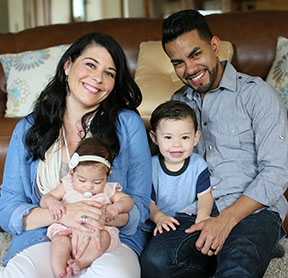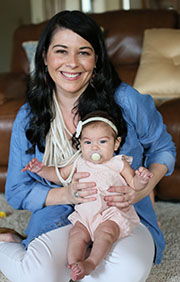“As I began feeling the effects of the anesthesia, I thought about the possibility of never seeing my husband, our 2-year-old son Anthony, or my family again. I thought about never having the chance to meet my unborn daughter.” Just 14 weeks into her second pregnancy, Angela Mason, 35, discovered her aortic stenosis, a heart condition caused by Bicuspid Aortic Valve Disease (BAVD), had progressed from moderate to severe, placing her and her unborn daughter, Hazel, in serious danger. In a heartbeat, Angela’s excitement turned into fear and uncertainty.
 BAVD is a congenital heart disease that affects only 1% of the U.S. population. In a normal heart, the aortic valve has three flaps through which blood flows. A bicuspid aortic valve has only two flaps, and it can degenerate at a younger age.
BAVD is a congenital heart disease that affects only 1% of the U.S. population. In a normal heart, the aortic valve has three flaps through which blood flows. A bicuspid aortic valve has only two flaps, and it can degenerate at a younger age.
“A bicuspid aortic valve is not rare, but developing severe aortic stenosis by
age 35 is uncommon,” explains Stephen Gimple, MD, Angela’s cardiologist. “Finding that the stenosis is severe and the patient is 14 weeks pregnant is an infrequent and dangerous scenario."
“In Angela’s situation, the risk of complications or even death to both Angela and her baby were very real.”
To handle the unique situation, Dr. Gimple and Angela’s obstetrician, Joy Clore, DO, worked together to develop a detailed plan of care for Angela’s pregnancy, labor and delivery. They assembled a multidisciplinary team that included perinatologists, anesthesiologists, cardiothoracic anesthesiologists and a cardiothoracic surgeon.
“After consulting with physicians from around the country, we determined North Kansas City Hospital had all the resources needed to achieve a positive outcome,” Dr. Clore says.
Plan of Action
 Keeping in mind there was a distinct possibility the surgeons would need to perform emergency heart valve surgery on Angela during the delivery, the team decided Angela would deliver Hazel by a scheduled Cesarean section in the cardiovascular operating suite under general anesthesia. Nurses created a makeshift nursery outside the OR so the baby could receive immediate care and be close to her mother.
Keeping in mind there was a distinct possibility the surgeons would need to perform emergency heart valve surgery on Angela during the delivery, the team decided Angela would deliver Hazel by a scheduled Cesarean section in the cardiovascular operating suite under general anesthesia. Nurses created a makeshift nursery outside the OR so the baby could receive immediate care and be close to her mother.
The team weighed the risks of delivering the baby too early, which can lead to complications from prematurity, against the risks of waiting too long, leading to possible heart failure in Angela. “We scheduled the birth at 36 weeks to lower the risk of Angela going into spontaneous labor,” Dr. Clore explains. “Hazel had a very low risk of having any serious conditions related to prematurity.”
“It wasn’t until the nurses arrived to take me to the operating room that I fully grasped the gravity of my situation.”
The night before the delivery, Angela checked into North Kansas City Hospital’s Labor & Delivery area. “It wasn’t until the nurses arrived to take me to the operating room that I fully grasped the gravity of my situation,” Angela says. “I realized how invested the hospital was in me and my family when my nurses wheeled me out of the room and there were 20 other nurses outside my door clapping and shouting words of encouragement. It was overwhelming.”
Sobbing, Angela said goodbye to her family for what could be the last time, and the OR team wheeled her into surgery.
Welcome, Hazel
 Angela woke in the Cardiac Intensive Care Unit a few hours later. Hazel weighed a healthy 6 pounds, 16 ounces, but needed a little extra attention in the Neonatal Intensive Care Unit. Angela’s health wasn’t in the clear either. Serious complications were still possible up to 48 hours after the delivery as Angela’s body processed the excess blood created by the pregnancy.
Angela woke in the Cardiac Intensive Care Unit a few hours later. Hazel weighed a healthy 6 pounds, 16 ounces, but needed a little extra attention in the Neonatal Intensive Care Unit. Angela’s health wasn’t in the clear either. Serious complications were still possible up to 48 hours after the delivery as Angela’s body processed the excess blood created by the pregnancy.
Because both Angela and Hazel were confined to ICUs, their first mother-daughter snuggle had to wait. But the nurses had other plans.
“The day after surgery, the nurses told me that if I could get into a wheelchair, they would take me to see Hazel,” Angela recalls. “That’s not a common occurrence for ICU patients, and it took a lot of people to move me because of the number of wires and monitors attached to my body.”
Nearly seven months later, Angela is still amazed at the level of care she received. “The doctors and nurses were awesome,” she says. “They went beyond anything I could have asked them to do for my family.
“People ask me why I didn’t go to one of the larger area hospitals. It’s because I trust these people with my life. I’m thankful for my team at NKCH and what they did for me and Hazel.”